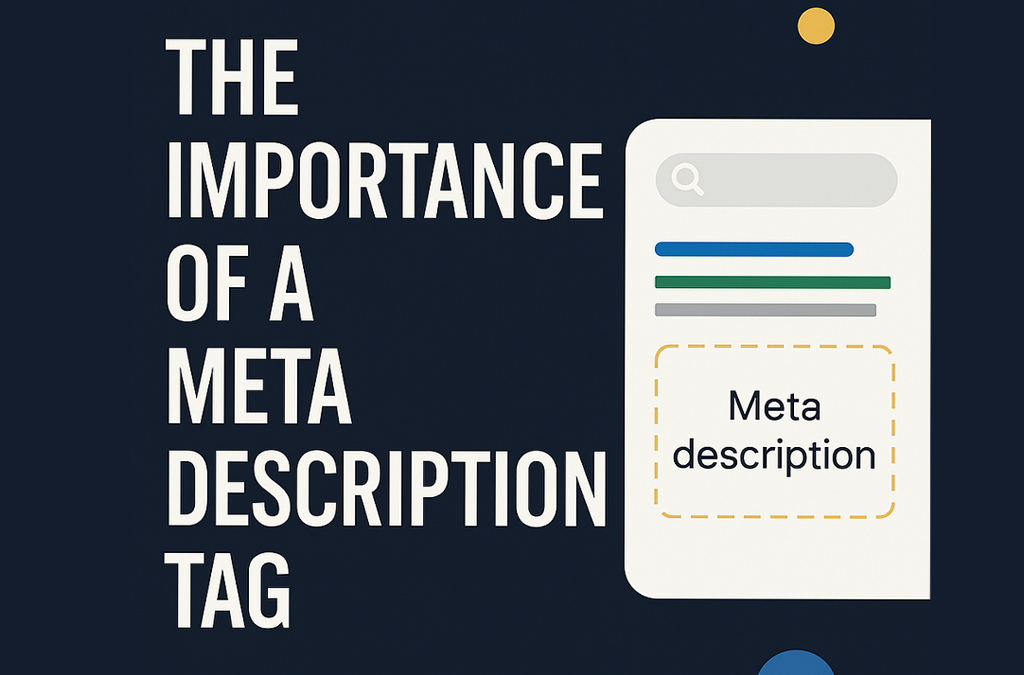Meta descriptions are often overlooked, yet they’re one of the most powerful tools for improving click-through rate (CTR) and shaping how your content appears in search results. While they don’t directly impact rankings, they influence the way users interact with your site, making them a core part of on-page SEO strategy.
What Is a Meta Description Tag?
A meta description is an HTML attribute that provides a brief summary of a webpage’s content. Typically between 120–160 characters, it appears under your page’s title in search engine results. Although Google sometimes rewrites them based on the query, a well-crafted meta description gives you control over how your content is presented.
Why Meta Descriptions Matter
-
Improves Click-Through Rate (CTR): A/B tests show a potential 5–15% increase in CTR with well-optimized descriptions.
-
Reinforces Relevance: Helps users quickly assess whether your page matches their intent.
-
Supports Brand Messaging: Acts as a micro-ad for your brand’s voice and value.
-
Enhances Social Sharing: Appears in preview text when shared on social platforms.
-
E-E-A-T Alignment: Communicates authority and trust at a glance.
Google’s View: CTR-Driven Influence
Google has confirmed that meta descriptions are not a direct ranking factor. However, they have indirect influence through behavioral signals:
-
Higher CTR
-
Lower bounce rates
-
Increased dwell time
“While Google doesn’t use meta descriptions directly in its ranking algorithms, they can influence whether users decide to click. Good descriptions can increase CTR and ultimately help pages perform better in search.” — Google Search Central Blog
Descriptions that match user intent are also more likely to appear exactly as written, instead of being replaced by automated snippets. This is a rare opportunity to influence both visibility and user engagement.
How to Optimize Meta Descriptions (Expert Strategy)
Key Principles:
-
Performance-Driven Optimization: Let CTR guide updates.
-
Strategic Prioritization: Focus on high-traffic and high-value pages.
-
Continuous Testing: A/B test variations to improve performance.
-
Holistic SEO: Align descriptions with title tags, headers, and on-page content.
When and How to Update:
-
No fixed schedule — use data triggers:
-
Low CTR (Search Console)
-
Ranking drops (Semrush, Ahrefs)
-
Changes in product/offers
-
Seasonal or trend shifts
-
-
After changes, Google may reindex in 3–14 days, depending on site authority.
Your Maintenance Strategy (Performance-Triggered)
High-Impact Pages (Homepage, Product/Service Pages)
-
Triggers: Low CTR, keyword shifts, intent changes, conversion drops
-
Focus: Strategic keywords, compelling tone, mobile-friendly, test variants
Mid-Tier Pages (Blogs, Resource Pages)
-
Triggers: High impressions + low CTR, declining traffic, content refreshes
-
Focus: Clear value, curiosity-driven copy, aligned with current trends
Low-Priority Pages (Archived or Legacy Content)
-
Triggers: Sudden traffic change, technical SEO updates
-
Focus: Relevance, accuracy — consider noindexing if the page no longer serves purpose
What Makes a Good Meta Description
-
Length: 120–160 characters
-
Clarity: Communicate value fast
-
Keywords: Use naturally for SERP bolding
-
Action-Oriented Language: “Discover,” “Learn,” “Compare”
-
Uniqueness: Avoid duplicate tags across pages
Recommended Formula (Marketing School Framework)
Many marketing schools (e.g., HubSpot Academy, DMI) suggest a 3-part breakdown:
-
Hook (25–40 characters): Grab attention
-
Value Proposition (40–80 characters): What’s in it for the user?
-
Call to Action (20–40 characters): Prompt the click (“Learn More,” “Start Today”)
Common Mistakes to Avoid
-
Leaving it blank (forces Google to improvise)
-
Reusing the same description sitewide
-
Keyword stuffing
-
Writing vague or misleading content
-
Overpromising what the page doesn’t deliver
Meta Descriptions & E-E-A-T
Even in a short description, you can reinforce:
-
Experience: “10+ years of trusted results.”
-
Expertise: Mention accreditations, if relevant.
-
Authoritativeness: Unique methodology or insight.
-
Trustworthiness: Match the tone of the landing page.
Tools of the Trade
-
Google Search Console: CTR, impression, and query data
-
Google Analytics: Track user behavior and conversions
-
Semrush / Ahrefs: Keyword + competitor research
-
Google Trends: Validate search intent
-
AnswerThePublic: Discover phrasing users are actually searching
-
Screaming Frog: Flag duplicates or missing tags
-
Google Optimize / Optimizely: Run A/B tests on snippets
The meta description may not directly affect rankings, but its role in shaping how users perceive and interact with your content makes it crucial. Treat each one like a mini-ad for your page — focused, relevant, and written with intent.
By prioritizing CTR and using real-world data to guide updates, you’re not just improving SEO — you’re connecting more effectively with your audience.
